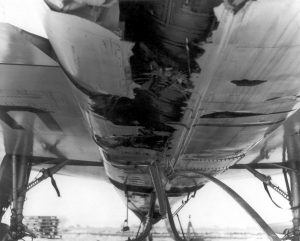2 February 1970 – A Convair F-106A-100-CO Delta Dart, 58-0787, of the 71st Fighter-Interceptor Squadron, out of Malmstrom AFB, piloted by Capt. Gary Faust entered a flat spin during a routine training flight conducting aerial combat maneuvers on February 2, 1970. Faust follows procedures and ejects from the aircraft.
The reduction in weight and change in center of gravity caused by the removal of the pilot, coupled with the blast force of his seat rocketing out of the plane pushing the nose of the aircraft down, which had been trimmed by Faust for takeoff and idle throttle, caused the aircraft to recover from the spin.
One of the other pilots on the mission was reported to have radioed Faust during his descent by parachute that “you’d better get back in it!”. From his parachute, Faust watched incredulously as the now-pilotless aircraft descended and skidded to a halt in a farmer’s field near Big Sandy, Montana. Faust drifted into the nearby mountains. He was later rescued by local residents using snowmobiles.
Shortly thereafter the local sheriff and local residents arrived at the scene of the crash.  The
The  thrust from the still-idling jet engine allowed the aircraft to slowly drift on its belly along a field. The sheriff, having contacted the airbase, was informed that he should simply allow the jet to run out of fuel, which occurred an hour and forty-five minutes later without further incident. A recovery crew from McClellan Air Force Base arrived on the scene and began to dismantle the aircraft, removing its wings for transport aboard a railroad flatcar. The damage to the aircraft was minimal; indeed, one officer on the recovery crew is reported to have stated that if there were any less damage he would have simply flown the aircraft out of the field.
thrust from the still-idling jet engine allowed the aircraft to slowly drift on its belly along a field. The sheriff, having contacted the airbase, was informed that he should simply allow the jet to run out of fuel, which occurred an hour and forty-five minutes later without further incident. A recovery crew from McClellan Air Force Base arrived on the scene and began to dismantle the aircraft, removing its wings for transport aboard a railroad flatcar. The damage to the aircraft was minimal; indeed, one officer on the recovery crew is reported to have stated that if there were any less damage he would have simply flown the aircraft out of the field. 
Following its misadventure, the “Cornfield Bomber” was repaired and returned to service, operating with the 49th Fighter-Interceptor Squadron, the final Air Force unit to operate the F-106. Faust flew the aircraft again in 1979 while training at Tyndall Air Force Base.
Upon its retirement, it was presented to the National Museum of the United States Air Force in August 1986, where it remains on display.
To read a great article and see more photos of the “Cornfield Bomber go to Historic Wings, The Online Magazine of Aviators, Pilots, and Adventurers Since 1997. http://fly.historicwings.com/2013/02/the-cornfield-bomber/
Source: Wikipedia
